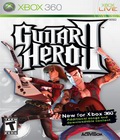Genre: Rhythm/Puzzle
Publisher: Red Octane
Developer: Harmonix
Release Date: November 7, 2006
There's something special about guitars. Don't get me wrong; other instruments are great, but the guitar holds a special allure that no other can match. Countless aspiring musicians dream of playing the guitar on a stage in front of a cheering crowd, but unfortunately for most of us, we don't have the talent of Bruce Springsteen. However, thanks to Activision and Red Octane's Guitar Hero franchise, even normal people have, for a brief moment, a chance to be a rock star. While Guitar Hero II doesn't quite put you on stage, it's the next best thing.
Last year, Guitar Hero came out of nowhere to capture the hearts of gamers across the nation. Created by Harmonix Music Systems, a fairly obscure developer responsible for a few cult favorite rhythm titles like FreQuency and Amplitude, and Red Octane, a group better known for their Dance Dance Revolution accessories than their games, it didn't seem to be a recipe for success. The game was released to moderate success at first, until word of mouth began to spread and people actually had a chance to try out Guitar Hero. Most who played it were hooked, and Guitar Hero's popularity skyrocketed overnight. The success of the title was so great that popular publisher Activision ended up purchasing Red Octane, so it should come as no great shock that a game with this much popularity gets a sequel.
Those who played the original Guitar Hero will find the sequel to be very familiar. As the old saying goes, "If it ain't broke, don't fix it," and Activision and Red Octane took that to heart for Guitar Hero II. The game plays almost functionally identical to its predecessor, but that isn't a bad thing at all. Rather than playing with a generic Dual Shock, players use a special guitar-shaped controller, which allows them to really feel like they're rocking out on stage. Players take on the role of an aspiring band member, and you go from a ratty dive all the way up to a worldwide concert at Stonehenge, playing new and more difficult songs with each venue. Of course, those who just want to jam can do a Quick Play, too.
What would Guitar Hero be without the songs? Guitar Hero II brings over 50 new tunes to the table, with countless big-name rock stars lending their music to the effort, from Van Halen and the Rolling Stones to Alice in Chains and Black Sabbath. From classic favorites like The Police's "Message in a Bottle" all the way to more obscure songs, like parody band Spinal Tap's "Tonight, I'm Gonna Rock You Tonight," the soundtrack lives up to the high standard set by the original Guitar Hero. With so many new songs and five unique difficulty settings, Guitar Hero II should keep gamers busy for months.
The biggest difference between Guitar Hero II and its predecessor is the difficulty. Hardcore fans will be glad to hear that a few tweaks have been made to make the game's harder modes significantly more challenging. Many of the new songs feature more difficult riffs and faster beats than those found in the original Guitar Hero, and a good percentage of the songs are also significantly longer. The 10-minute long "Freebird" for example, is such an endurance test that even on the easiest mode, it can be an exhausting challenge. Expert mode will make the original Guitar Hero's "Bark At The Moon" look like a cakewalk in comparison, and anyone who can get a perfect on Expert mode "Freebird" is a true master. Don't worry newcomers, Guitar Hero II also has an Easy setting, for those who just want to rock out.
Thankfully, Guitar Hero II also includes a very helpful practice mode. In this mode, players can pick a tune, choose specific segments, and then play them at one of four speeds, ranging from normal to super-slow, so those who had trouble with some of the tougher songs can brush up without replaying the entire tune.
One problem fans had with the original Guitar Hero was the lackluster multiplayer mode, where players "traded" riffs off to one another. It was fun, but being in a band is about harmony, not competition, and Guitar Hero II acknowledges that. While the original versus mode remains in the game, the new cooperative mode is sure to be what people play the most. Instead of trading off, one player takes the guitar section of a song, while the other takes the bass section. The two play through the song together, each fretting a different set of chords.
The real challenge is in using Star Power, which, in single-player mode, functions exactly as it does in the original Guitar Hero, doubling your point multiplier for a brief period of time. In co-op mode, however, both players must activate Star Power at the exact same moment, which means cooperation between the two "musicians" is the key to success.
All in all, Guitar Hero II looks to be a worthy sequel to the original. It makes just enough changes to keep the formula fresh, without diverging from the excellent gameplay that made the original so much fun. With almost twice the songs of the original, a much improved multiplayer mode and an increased difficulty, Guitar Hero II is everything a sequel should be. Even those who don't usually enjoy music games should give Guitar Hero II a try this November. It might just surprise you.
More articles about Guitar Hero II











 Guitar Hero II arrives with a new track list, new venues and additional play modes – including the ability to transform the original Guitar Hero SG Controller into a rhythm, lead or bass guitar.
Guitar Hero II arrives with a new track list, new venues and additional play modes – including the ability to transform the original Guitar Hero SG Controller into a rhythm, lead or bass guitar.























